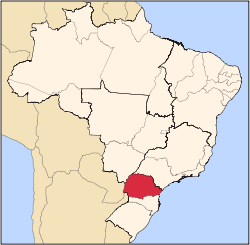Morretes
Morretes is a small historic city of the Brazilian state of Paraná. It has a population of around 18,000 people. It is famous for its restaurants, especially a traditional dish called barreado. It is also the home of many historical monuments.
Morretes | |
|---|---|
| Município de Morretes Municipality of Morretes | |
Morretes, July 2008 | |
 Flag  Seal | |
| Motto(s): A Cidade da Gente (Our City; The People's City) | |
 Location of Morretes in Paraná | |
 Morretes Location of Morretes in Brazil | |
| Coordinates: 25°28′37″S 48°50′02″W | |
| Country | |
| Region | South |
| State | |
| Mesoregion | Curitiba (metropolitan) |
| Microregion | Paranaguá |
| Founded | October 31, 1733 |
| Founded by | Rafael Pires Pardinho |
| Government | |
| • Mayor | Rafael Greca (PMN) |
| Area | |
| • Total | 648.580 km2 (250.418 sq mi) |
| Population (2010) | |
| • Total | 15,718 |
| • Density | 22.96/km2 (59.5/sq mi) |
| Time zone | UTC-3 (UTC-3) |
| • Summer (DST) | UTC-2 (UTC-2) |
| Website | Official website |
History
Etymology
The name "Morretes" is a geographical reference to the morros (Portuguese for "hills") that surround the city.
Geography
Morretes can be reached by road or by taking the historical Serra Verde Express train from Curitiba, or the touristic Paranagua-Curitiba Railway.
Main sights
Overview
Saint Benedict's Church (Igreja de São Benedito): There are a lot of attractions in Morretes. One of them is the Saint Benedict's Church. In 1760, the Brotherhood of Saint Benedict was founded in Morretes. Between 1865 and 1895 the chapel and the cemetery were built, not without some difficulty, as the region was going through a period of economic decadence. Its architecture is composed of the simplest edified scheme of the religious tradition: nave, bell-tower and main chapel. Inside there are many images from different times, including one of the patron saint, the "glorious St. Benedict".
Old Bridge (Ponte Velha): A steel bridge over the Nhundiaquara river that gives access to restaurants like Madalozo. Pedestrians share space with cars, considering that there is just one lane.
Touristic Train (Trem Turístico): Leaving Curitiba for Paranaguá, it passes through and stopping in Morretes. The train, which travels around 74 km between both Paraná's cities, consists of 18 wagons divided in three classes: economic, touristic and executive.
Marumbi Peak (Pico do Marumbi): Located in Paraná’s sea mountain, the state park of Marumbi remains covered in natural Brazilian Atlantic forest vegetation. Activities such as waterfall bathing, trail walking and climbing are done in this place.
Flower Street (Rua das Flores): The main street of Morretes, a boardwalk on the banks of the Nhundiaquara river with historic mansions such as the house where D. Pedro II slept, Marco Zero, fountain, restaurants and the city's first telegraph.
Conservation units
The municipality contains:
- 8,745 hectares (21,610 acres) Pico do Marumbi State Park, created in 1990[1]
- 1,190 hectares (2,900 acres) Graciosa State Park, created in 1990[2]
- 6% of the 199,587 hectares (493,190 acres) Guaratuba Environmental Protection Area, created in 1992[3]
- 61% of the 2,699 hectares (6,670 acres) Roberto Ribas Lange State Park, created in 1994[4]
- 906 hectares (2,240 acres) Pau Oco State Park, created in 1994[5]
- About 19% of the 49,287 hectares (121,790 acres) Guaricana National Park, created in 2014 to protect a mountainous area of Atlantic Forest[6]
References
- Requião, Roberto; Rodrigues, Lindsley da Silva Rasca; Verri, Enio José (2 October 2007), Decreto 1531 - 02 de Outubro de 2007 (in Portuguese), State of Paraná, retrieved 2016-11-19
- PES da Graciosa (in Portuguese), ISA: Instituto Socioambiental, retrieved 2016-11-16
- APA Guaratuba (in Portuguese), ISA: Instituto Socioambiental, retrieved 2016-11-19
- PES Roberto Ribas Lange (in Portuguese), ISA: Instituto Socioambiental, retrieved 2016-11-17
- Pereira, Mário; Sorotiuk, Vitório (21 November 1994), Decreto 4266 - 21 de Novembro de 1994 (in Portuguese), State of Paraná, retrieved 2016-11-19
- PARNA Guaricana – ISA.
- PARNA Guaricana (in Portuguese), ISA: Instituto Socioambiental, retrieved 2016-06-16
External links
| Wikivoyage has a travel guide for Morretes. |

- (in Portuguese) Morretes official website
